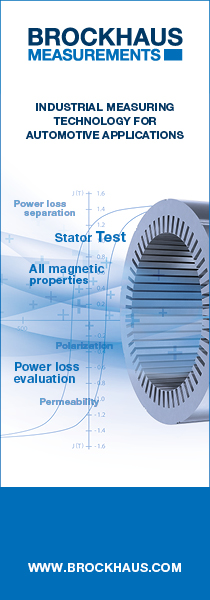MMA25 – Magnetic Materials and Applications 2025
UKMagSoc
MMA25
Oct 8th 2025 - Oct 9th 2025
Kochel, Germany
Last Update: 6/10/25
* Accommodation options added below
Taxi Shuttle
The taxi shuttle from Kochel to the Zentrum will run
8 October
- 08:00 – 09:30 Hotel Alpenhof Postillion, Kochel – Zentrum, Benediktbeuern
- 21:00 – 22:00 Kloster Bräustüberl, Benediktbeuern – Hotel Alpenhof Postillion
9 October
- 08:00 – 09:30 Hotel Alpenhof Postillion, Kochel – Zentrum, Benediktbeuern
THE LEADING EVENT FOR MAGNETIC MATERIALS & APPLICATIONS
The UK Magnetics Society invites you to join MMA25, our flagship international event dedicated to research and innovation in magnetic materials and their applications.
Over two days of talks, networking, and technical tours, you’ll connect with global experts advancing magnetic innovation across industries including automotive, aerospace, energy, industrial, and research.
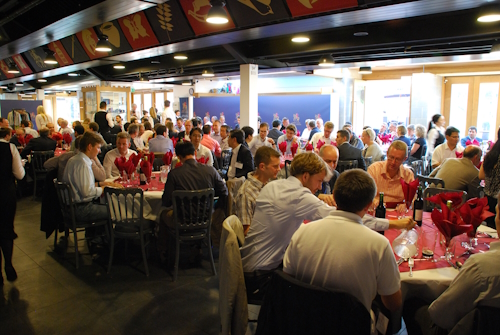
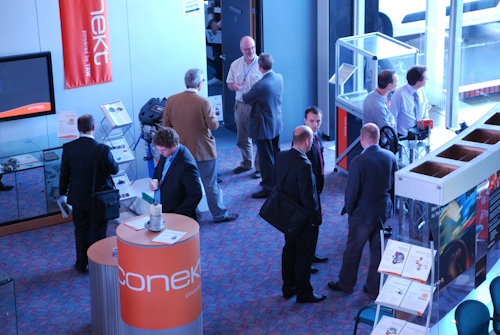
sponsored by


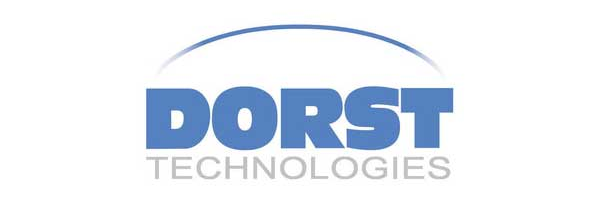
SPEAKERS & PRESENTATIONS
Hear from leaders in magnetic research and applications:
Latest Draft Programme, v5:
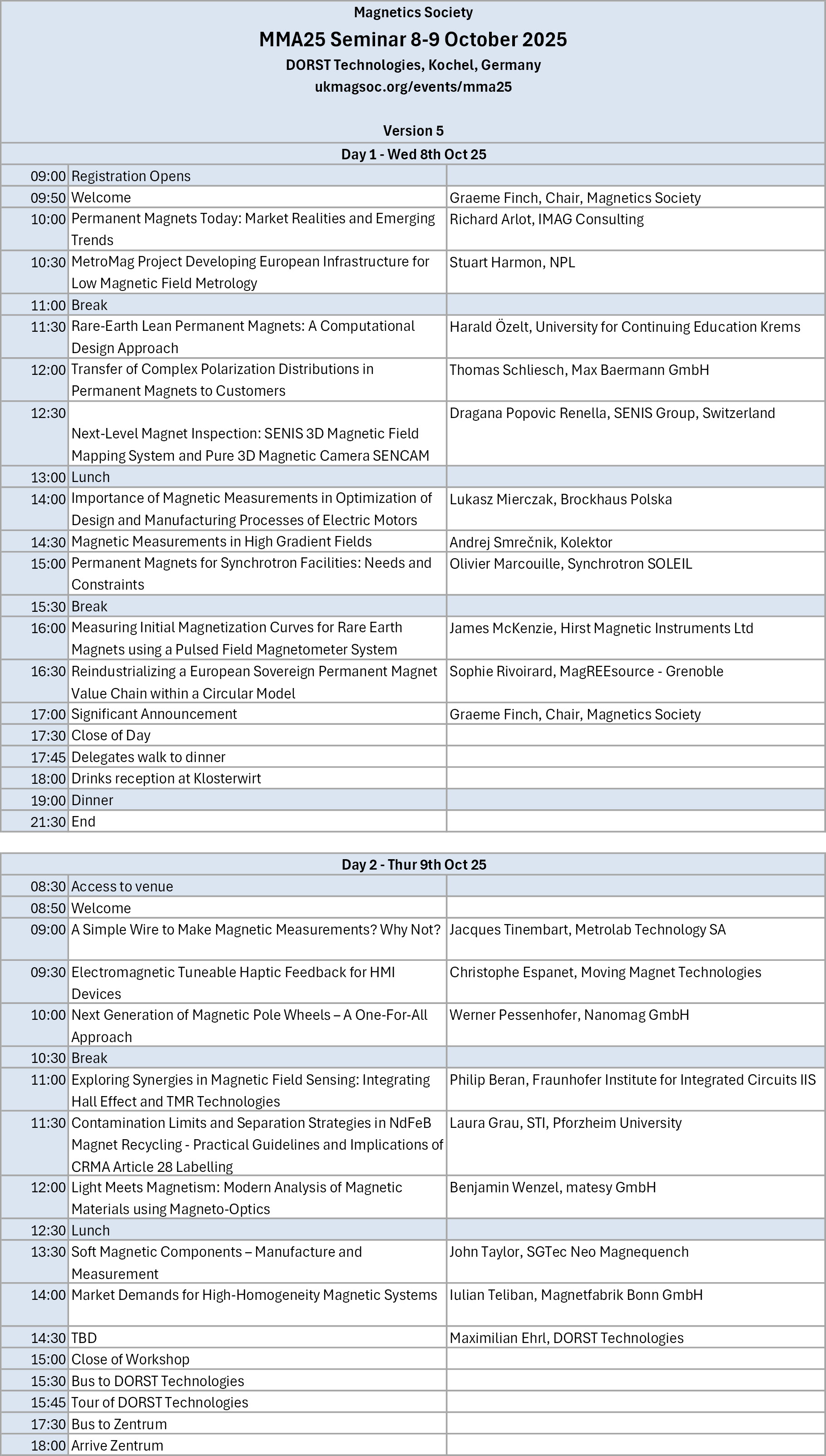
NETWORKING & SOCIALS
- Arrival Reception – 7 Oct TBC
- Conference Dinner – 8 Oct
TECHNICAL TOUR
We have a unique tour to DORST Technologies in Kochel, manufacturer of manufacturing machinery – in particular magnet production tools.
VENUES
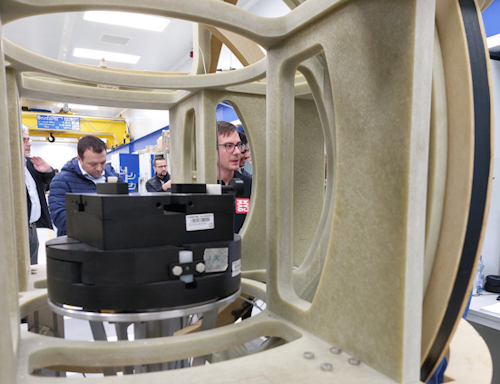
Venue change
Unfortunately due to the on-going political situation in Serbia we have taken the difficult decision not to take MMA to Serbia this year as planned. We apologise for any incovenience caused by this change at this time, and we very much hope to hold MMA in Serbia in the near future.
SPONSORS & PACKAGES
MMA25 offers excellent sponsorship opportunities to raise your profile across the international magnetics community.
Sponsorship levels: Ceramic | Ferrite | Samarium | Neodymium
Benefits include exhibition space, marketing exposure, delegate pack inserts, branded materials, and dinner sponsorship opportunities.
Contact us for more information on sponsor packages.
TRAVEL & ACCOMMODATION
The venue is about an hour from Munich by train, and by car sits on Bundesstraße 11.
Benediktbeuern and Kochel are both on a direct train line from Munich Hbf.
Accommodation is a little dispersed in the beautiful area of Kochel and Benediktbeuern. The hotels below have room availaiblity at the time of writing. Please contact them directly by their website or by phone to book a room.
We MAY be able to organise transport between the hotels and the venue at Zentrum, but a bus between the Zentrum and DORST Technologies WILL be available.
Please let us know which hotel you are staying at.
EVENT INFORMATION
- Dress code: Business / Smart casual
- Dietary requirements: Please advise us when registering
- Photos: Contact us if you prefer not to appear in event photos
Continuing Contact / GDPR
By providing your contact details during registration, you authorise us to
- use these contact details to let you know details of this event, and
- add your contact details to our contact database
Please let us know at enquiries@ukmagsoc.org at any time if you do not wish to be contacted in this way.
ATTEND MMA25
Join us at MMA25 in Kochel, Germany to connect with the brightest minds in magnetics, and explore the future of materials and applications.
EVENT SPONSORS



Speakers
Next Generation of Magnetic Pole Wheels – A One-For-All Approach
by Werner Pessenhofer of Nanomag GmbH
Whether robotics & cobots, industrial automation, oil & mining, medical technology, aviation and defence technology, off-highway & construction machinery.
The precise measurement of rotational speed and/or rotation angle is the basis for the movement, positioning and motion of axes and systems.
Until now, several different technologies are used to cover the different requirements: gear wheels, sintered rings, elastomer based rings.
With Nanomags brandnew SmCo-based pole wheels we set a benchmark in precision, extreme robustness and versatility together with outstanding lightweight possibilities – a One-for-all solution.
The outstanding properties of our new polewheel technology compared to state-of-the-art solutions will be presented together with end-customer benefits of using them.
Measuring Initial Magnetization Curves for Rare Earth Magnets using a Pulsed Field Magnetometer System
by James McKenzie of Hirst Magnetic Instruments Ltd
This presentation will review recent progress and results gained from the Hirst generation 8 Pulsed Field Magnetometers on initial magnetisation curves. The initial curve represents the initial magnetization process of a permanent magnet from when it is completely unmagnetized. This curve is important for understanding the composition, metallurgy, and microstructure of a material. We will present results for NdFeB and SmCo magnets. This new option on the latest generation 8 PFMs from Hirst takes advantage of the full pulsed field that drives the sample through all four quadrants of the hysteresis loop during a measurement.
Transfer of Complex Polarization Distributions in Permanent Magnets to Customers
by Thomas Schliesch of Max Baermann GmbH
Some specific manufacturing methods for permanent magnets, as those as injection molding, often lead to complex distributions of inherent parameters like remanent polarization or recoil permeability. Knowledge about those distributions can be crucial for the magnet’s customers when doing their own simulations and predictions about the performance of the final application. Examples are simulations of complex magnets in electrical machines, magnetic sensors or magnetic couplings. In many cases it can be difficult to do a direct transfer of data from the magnet’s manufacturer to the end customer due to the use of different simulation systems or by restrictions by the customer’s software.
The presentation will start with descriptions of how related distributions of magnetic parameters can be gained by adequate simulations at the manufacturer’s site. It will then explain the various ways how sufficient transfer of data to the customer’s end can be performed. When not using same simulation systems by the magnet producer and the customer, a transfer by use of discrete local distributions can be an option. Unfortunately, many commercial software packages have problems with implementing respective distributions by element or volume-wise changing of material data. As a solution, sometimes heuristic models provide sufficient results, but often with poor accuracy. Instead of that, many numerical packages can handle distributions of inherent magnetic parameters like the polarization vector by mathematical equations. So, the talk will provide various attempts for mathematical approximations to feed respective software systems with magnetic distributions of periodic as well as non-periodic kind. A variety of simulations of different sorts of magnets will be presented together with comparative measured data.
Importance of Magnetic Measurements in the Optimization of Design and Manufacturing Processes of Electric Motors
by Lukasz Mierczak of Brockhaus Polska
Accurate design and prediction of electric motor performance is not a trivial task. Motor design engineers make use of advanced numerical and analytical methods for electromagnetic and thermal analysis, and still find considerable differences in efficiency of modelled and manufactured machines. One of the primary sources for this mismatch is the inaccuracy in stator lamination magnetic properties, such as BH curve and power loss, which are used as input data for calculating flux linkages of the coils and heat dissipation, and consequently determining the main motor parameters including torque and operating temperature. Typically, the magnetic properties implemented in motor modelling are provided by the material supplier based on the Epstein frame measurements, according to the International Standard IEC 60404-2. The effects of processing of the magnetic materials during motor manufacturing are neglected which gives rise to uncertainty in prediction of motor performance. In this presentation the results from industrial case studies involving advanced magnetic measurements will be presented, including characterization of stress sensitivity of soft magnetic materials, optimization of stamping and stacking methods in production of stator cores, as well as evaluation of manufacturing technologies for mitigation of eddy current loss in permanent magnets. Moreover, the presentation will explore the direct correlation between the deterioration in magnetic properties and the inferior performance of EV IPM electric motor to emphasize the importance of maintaining the quality of stator cores to ensure optimal powertrain performance
Reindustrializing a European Sovereign Permanent Magnet Value Chain within a Circular Model
by Sophie Rivoirard of MagREEsource - Grenoble
This presentation will focus on MagREEsource activities to set up a factory, producing Rare Earth based permanent magnet in France. After a short introduction on the context of chinese monopoly on Rare Earth together with their recent export ban on magnets, the talk will focus on the reindustrialization of a complete magnet value chain based on a circular model in order to produce magnet from recycled origin.
Rare-Earth Lean Permanent Magnets: A Computational Design Approach
by Harald Özelt of University for Continuing Education Krems
High-performance permanent magnets, indispensable for green technology, heavily rely on rare-earth elements, which are associated with significant supply risks and negative environmental impacts. This research focuses on the development of rare-earth lean permanent magnets that retain excellent magnetic properties by a) optimizing the spatial distribution of soft and hard magnetic phases and b) tailoring microstructural features. To overcome the length scale limitations of conventional micromagnetic simulations, we developed a reduced-order model that enables the investigation of structural influences on the performance of sintered magnets. This model facilitates the analysis of how microstructural characteristics affect key magnetic properties.
Machine learning plays a vital role in accelerating magnet optimization. We employ a Graph Neural Network (GNN) to predict coercivity and energy product based on multigranular microstructures. To explore optimal compositions of hard and soft magnetic materials, a Convolutional Neural Network (CNN) is trained to predict the energy product. This CNN serves as a surrogate model within a binary optimization framework to identify beneficial spatial arrangements of magnetic phases. The proposed designs are validated through micromagnetic simulations and used to enrich the training dataset in an active learning loop.
This research was funded in whole or in part by the Austrian Science Fund (FWF): 10.55776/I6159 and 10.55776/P35413.
Electromagnetic Tuneable Haptic Feedback for HMI Devices
by Christophe Espanet of Moving Magnet Technologies
MMT introduces a novel actuator topology for designing Human-Machine Interfaces (HMI) that deliver haptic feedback using electro-permanent magnets. This approach offers two key advantages: the actuator operates without physical contact, and the haptic response can be magnetically tuned. During the presentation, we will give the design model and methodology, along with measurement results from several prototypes, demonstrating the versatility and adaptability of the proposed structure.
A Simple Wire to Make Magnetic Measurements? Why Not?
by Jacques Tinembart of Metrolab Technology SA
Faraday’s law of induction can be used in many situations to assess the rough value of a magnetic field, determine the position of the center of a coil or be used to make very precise measurements.
We will explore several configurations in which voltage integration can be used to assess the magnetic field density of a magnetic structure.
Light Meets Magnetism: Modern Analysis of Magnetic Materials Using Magneto-Optics
by Benjamin Wenzel of matesy GmbH
Magneto-optical measurement technologies can offer extremely high lateral resolutions for stray field analyses. Matesy GmbH's measuring instruments ensure a lateral resolution of up to 15 µm for industrial applications. Simultaneously, they provide high acquisition speeds of up to 10 frames per second for regions as large as 23 cm² in a single shot. As of now, special analysis software is in the process of being developed. This software will generate measurement results that adhere to established standards and incorporate automated tools. The measurement method will be explained using example applications from industry and research.
Measurement of magnets with high gradient magnetization in production environment
by Andrej Smrečnik of Kolektor Mobility d.o.o.
Constant push towards miniaturization of sensors and actuators forces manufacturers to use high magnetic density materials. Smaller dimensions together with high spatial magnetic gradients patterning result in high gradient of magnetic field generated by such products.
At the same time there is push towards narrower and narrower tolerances also for magnetic properties of these products.
Production quality control therefore faces new challenges regarding achievable measuring accuracy even when using state of the art magnetic measuring systems.
Analysis of real world example.
Permanent Magnets Today: Market Realities and Emerging Trends
by Richard Arlot of IMAG Consulting
This talk provides a data-driven snapshot of the permanent magnet industry, highlighting the latest market dynamics, emerging R&D directions, and key industrial applications. Beyond the headlines and geopolitical noise, the presentation identifies real trends shaping the sector, with insights into technological innovation, supply chain evolution, and application-driven demand. Attendees will gain a clear and pragmatic view of where the market stands today — and where it is heading.
Next-Level Magnet Inspection: SENIS 3D Magnetic Field Mapping System and Pure 3D Magnetic Camera SENCAM
by Dragana Popovic Renella of SENIS Group, Switzerland
Accurate magnetic field measurement is essential for industries requiring precise magnet inspection in R&D, QA, and production. SENIS provides two cutting-edge solutions: the MMS-1A-RS Magnetic Field Mapping System, which measures Bx, By, Bz, and Btotal at a single point in space, and the SENCAM, a matrix of pure 3D Hall sensors, each measuring Bx, By, Bz, and Btotal at a single point.
The MMS-1A-RS mapper is primarily used in R&D, QA, and small-volume production, offering automated, high-resolution mapping of magnetic fields in permanent magnets, electromagnets, and electronic components. It utilizes a non-magnetic Cartesian platform and advanced 3D Hall probes.
The SENCAM features over 16'000 pure 3D magnetic sensors (or 3-axis magnetic field pixels) for unparalleled resolution in capturing magnetic field strength and direction in QA and production. Its ultra-small field-sensitive volume (27 × 9 × 4 µm³ per 3D pixel) and high-speed imaging (7 full images per second or image partitions of interest per millisecond) enable detailed inspection on production lines, even for complex magnet geometries and high magnetic field gradients.
Both systems provide traceable accuracy, ISO 17025-certified calibration, and seamless software integration, making them invaluable tools for quality control, advanced magnetic engineering, and production line inspection.
Exploring Synergies in Magnetic Field Sensing: Integrating Hall Effect and TMR Technologies
by Philip Beran of Fraunhofer Institute for Integrated Circuits IIS
The rapid evolution of the market for magnetic sensors has created complex requirements for magnetic field sensors, necessitating technologies that simultaneously offer high bandwidth, wide dynamic range, and low power consumption. Most integrated magnetic field sensors use the Hall effect or magnetoresistance measurement principle, with TMR emerging as the most promising magnetoresistive technology. A comparative analysis reveals significant differences between Hall and TMR technologies regarding sensitivity, power consumption, and application suitability. Hall sensors are cost-effective and excel in high magnetic field environments, making them ideal for automotive and industrial applications. TMR sensors are optimal for ultra-low power applications requiring high sensitivity, particularly in medical and precision sensing tasks. The exploration of hybrid magnetic field sensors combining Hall and TMR technologies aims to mitigate each technology's disadvantages while enhancing performance. Challenges include monolithic integration and error detection for TMR elements. This presentation underscores the complementary roles of Hall and TMR sensors, offering insights for improved sensor selection and integration in modern applications.
Contamination Limits and Separation Strategies in NdFeB Magnet Recycling - Practical Guidelines and Implications of CRMA Article 28 Labelling
by Laura Grau of STI, Pforzheim University
The possibilities for separating common contaminants in the pre- and post-processing of short-loop recycled NdFeB permanent magnets are discussed, along with the acceptable contamination limits, to provide practical guidance for designing efficient recycling processes. This is contextualized with the labelling obligation arising from Article 28 of the Critical Raw Materials Act and the upcoming corresponding Implementing Act.
Soft Magnetic Components – Manufacture and Measurement
by John Taylor of SGTec Neo Magnequench
Many modern applications using bulk soft magnetic materials are pushing performance requirements away from traditional materials.
SGTec has developed solutions to some of the most challenging applications in bulk material soft magnetics.
This talk will go into some description of these applications and solutions.
Market Demands for High-Homogeneity Magnetic Systems
by Iulian Teliban of Magnetfabrik Bonn GmbH
The demand for highly homogeneous magnetic field systems is growing in applications such as medical diagnostics, sensor calibration, and industrial testing. Magnetfabrik Bonn addresses these needs with two complementary solutions: high-precision Halbach systems using discrete, temperature-stabilized magnets for maximum field uniformity, and cost-efficient designs based on polymer-bonded hard ferrite materials. This presentation will outline design strategies and application examples, showing how tailored magnetic systems can balance accuracy and cost to meet diverse market requirements.
MetroMag Project Developing European Infrastructure for Low Magnetic Field Metrology
by Stuart Harmon of NPL
Low magnetic field traceability is increasingly required for a range of key industry applications including sensors embedded in electric motors for electric mobility, and magnetic field-based diagnostics such as MRI in the medical sector. However, only a few European National Measurement Institutes (NMIs) have the required capabilities to perform traceable measurements down to the µT level. This 3-year European project started in July 2025, includes 11 NMIs and several academic and industrial partners with the aim to develop novel methods to cancel environmental magnetic fields, develop easier and faster comparison methodologies, and to establish a pan-European measurement infrastructure at these low magnetic field levels to address current and future industry requirements. The presentation will outline why this project is required, the project activities, and the expected benefits once completed.
Axial Press Systems for Aligning and Shaping of Magnet powders Under Inert Atmosphere
by Maximilian Ehrl of DORST Technologies
For more than 40 years, DORST TECHNOLOGIES has been developing and supplying press and spray dryer equipment for applications within the magnet industry. This includes mainly axial presses of different kinds and sizes for manufacturing of soft ferrite, hard ferrite, rare earth magnets and soft magnetic composites. Spray dryers are available for material preparation in the ferrite industry.
The recent developments in geopolitics have created a desire for reshoring technologies along the production chain from the raw mineral to the finished magnet within the western world. During the last couple of years, DORST has seen an unprecedented run on equipment for the compaction on NdFeB powders.
This presentation gives an insight into the latest state of its modern magnet presses including integrated solutions for inerting & particle alignment.
Permanent Magnets for Synchrotron Facilities: Needs and Constraints
by Olivier Marcouille of Synchrotron SOLEIL
Synchrotron facilities are light sources in which ultra-relativistic particles are stored and describe a circular path when crossing magnetic equipment, such as bending magnets, devoted to deviating them or magnetic quadrupoles used to focus the electron beam similarly to an optical lens. Some other magnetic equipment, called insertion devices, are dedicated to producing light in a spectral range chosen by scientists. The use of permanent magnets for insertion devices has been accelerated since the middle of 1980’s, with the development of material of high remanent magnetization and recently for bending magnets and magnetic quadrupoles with the construction of many 4th generation synchrotron facilities. The presentation will focus on the principle of operation of magnetic equipment of a synchrotron and will emphasize the need and constraints and also the impact of defaults of permanent magnet (magnetization, magnetic orientation, inhomogeneity inside blocks) on the magnetic performance.
Registration
| Type |
Standard Fee |
Group Discount (3+ delegates) |
| Speaker |
£295.00 |
20% |
| Delegate - Member of UKMS or REIA |
£395.00 |
20% |
| Non-Member Delegate |
£495.00 |
20% |
| Student |
£295.00 |
20% |
| Exhibiting (includes 2 delegates) |
£1,195.00 |
20% |
Register to attend this event 






